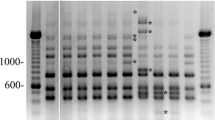Abstract
Forty-eightSerratia strains associated with insects were, identified to species level and biotyped according to recent taxonomic schemes. Each strain was submitted to 36 biochemical tests, including 23 carbon source utilization tests. Twenty-eight strains were assigned to eight biotypes ofSerratia marcescens: A1a, A2a, and A6a (pigmented biotypes: 18 strains); and A3a, A3b, A4a, A5, and TCT (nonpigmented biotypes: 10 strains). However, biotypes A8a, A8b, and A8c, which are frequently involved in nosocomial infections, were not found in insects. Ninetten strains were identified asS. liquefaciens (S. proteamaculans) biotypes C1a (12 strains), C1c (4 strains), C1d (2 strains), and one atypicalS. liquefaciens strain. Only one strain was identified asS. marinorubra (a nonchitinolytic species). The recent emergence ofSerratia in human pathology calls for a reevaluation of the idea of usingSerratia to biologically control insects.
Similar content being viewed by others
Literature Cited
Altemeier, W. A., Culbertson, W. R., Fullen, W. D., McDonough, J. J. 1969.Serratia marcescens septicemia. A new threat in surgery. Archives of Surgery99:232–238.
Bergey, D. H., Harrisson, F. C., Breed, R. S., Hammer, B. W., Huntoon, F. M., 1923. Bergey's manual of determinative bacteriology, 1st ed Baltimore: Williams & Wilkins.
Brenner, D. J., Farmer, J. J., III, Fanning, G. R., Steigerwalt, A. G., Klykken, P., Wathen, H. G., Hickman, F. W., Ewing, W. H. 1978. Deoxyribonucleic acid relatedness ofProteus andProvidencia species. International. Journal of Systematic Bacteriology28:269–282.
Broquet, C. 1910. Le rouge du papillon du ver-à-soie en Cochichine. Annales de l'Institut Pasteur24:529–542.
Bucher, G. E. 1963. Nonsporulating bacterial pathogens, pp. 117–147. In: Steinhaus, E. A. (ed.) Insect pathology, an advanced treatise, vol. 2 New York: Academic Press.
Bucher, G. E., Stephens, J. M. 1959. Bacteria of grasshoppers of western Canada: I. The Enterobacteriaceae. Journal of Insect Pathology1:356–373.
Burnside, C. E. 1928. A septicemic condition of adult bees. Journal of Economic Entomology21:379–386.
Clayton, E. D. W., von Gravenitz, A. 1966. NonpigmentedSerratia marcescens. Journal of the American Medical Association197:1059–1064.
Edwards, P. R., Ewing, W. H. 1972. Identification of Enterobacteriaceae, 3rd ed. Minneapolis: Burgess Publishing Co.
Farmer, J. J., III, Davis, B. R., Hickman, F. H., Presley, D. B., Bodey, G. P., Negut, M. H., Bobo, R. A. 1976. Detection ofSerratia outbreaks in hospitals. Lancet2:455–459.
Grimes, M. 1961. Classification of theKlebsiella-Aerobacter group with special reference to the cold-tolerant mesophilicAerobacter types. International Bulletin of Bacteriological Nomenclature and Taxonomy11:111–129.
Grimont, P. A. D., Grimont, F. 1978. Biotyping ofSerratia marcescens and its use in epidemiological studies. Journal of Clinical Microbiology8:73–83.
Grimont, P. A. D., Grimont, F. 1978. The genusSerratia. Annual Review of Microbiology32:221–248.
Grimont, P. A. D., Grimont, F., Dulong de Rosnay, H. L. C., Sneath, P. H. A. 1977. Taxonomy of the genusSerratia. Journal of General Microbiology98:39–66.
Grimont, P. A. D., Grimont, F., Richard, C., Davis, B. R., Steigerwalt, A. G., Brenner, D. J. 1978. Deoxyribonucleic acid relatedness betweenSerratia plymuthica and otherSerratia species, with a description ofSerratia odorifera sp. nov. (type strain: ICPB 3995). International Journal of System-atica Bacteriology28:453–463.
Grimont, P. A. D., Grimont, F., Starr, M. P. 1978.Serratia proteamaculans (Paine and Stansfied) comb. nov., a senior subjective synonym ofSerratia liquefaciens (Grimes and Hennerty) Bascomb et al. International Journal of Systematic Bacteriology28:503–510.
Landerkin, G. B., Katznelson, H. 1959. Organisms associated with septicemia in the honeybee,Apis mellifera. Canadian Journal of Microbiology5:169–172.
Lysenko, O. 1958. Contribution to the taxonomy ofCoccobacillus acridiorium d'Herelle. Folia Biologica4:342–347.
Lysenko, O. 1959. Report on diagnosis of bacteria isolated from insects (1954–1958). Entomophaga4:15–22.
Lysenko, O. 1963. Culture collection of entomogenous bacteria (CCEB). Catalogue of cultures, 3rd ed, Prague: Czechoslovak Academy of Sciences.
Lysenko, O. 1974. Bacterial exoenzymes toxic for insects: Proteinase and lecithinase. Journal of Hygiene, Epidemiology, Microbiology and Immunology18:347–352.
Lysenko, O. 1976. Chinase ofSerratia marcescens and its toxicity for insects. Journal of Invertebrate Pathology27:385–386.
Molise, E. M., Drake, C. H. 1973. Chitimolysis bySerratia includingSerratia liquefaciens (Enterobacter liquefaciens). International Journal of Systematic Bacteriology23:278–280.
Paillot, A. 1916. Existence de plusieurs variétés et races de coccobacilles dans les septicémies naturelles du hanneton. Comptes-Rendus Hebdomadaires des Séances de l'Académie des Sciences163:531–534.
Pesson, P., Toumanoff, C., Haradas, C. 1955. Etude des épizooties bactériennes observées dans les élevages d'insectes xylophages (Rhyncolus porcatus Germain,Scolytus scolytus Fabricius,Scolytus [Scolytochelus] multistriatus Marsham). Annales des Epiphyties6:315–328.
Steigerwalt, A. G., Fanning, G. R., Fife-Asbury, M. A., Brenner, D. J. 1976. DNA relatedness among species ofEnterobacter andSerratia. Canadian Journal of Microbiology22:121–137.
Steinhaus, E. A. 1941. A study of the bacteria associated with thirty species of insects. Journal of Bacteriology42:757–789.
Steinhaus, E. A. 1951. Report on diagnoses of diseased insects, 1944–1950. Hilgardia20:629–678.
Steinhaus, E. A. 1959.Serratia marcescens Bizio as an insect pathogen. Hilgardia28:351–380.
Weiser, J., Lysenko, O. 1956. Sepikemie bource morusového. Ceskoslovenska Mikrobiologie1:216–222.
White, G. F. 1923. Hornworm septicemia. Journal of Agricultural Research26:447–486.
White, G. F. 1923. Cutworm septicemia. Journal of Agricultural Research26:487–496.
Willes, H., Pinter, L. 1961. Recherches sur les septicémies bactériennes de l'abeille adulte en Suisse, pp. 64–80. In: Journées Internationales de Pathologie Apicole. Nice: Office International des Epizooties.
Author information
Authors and Affiliations
Rights and permissions
About this article
Cite this article
Grimont, P.A.D., Grimont, F. & Lysenko, O. Species and biotype identification ofSerratia strains associated with insects. Current Microbiology 2, 139–142 (1979). https://doi.org/10.1007/BF02605870
Issue Date:
DOI: https://doi.org/10.1007/BF02605870




